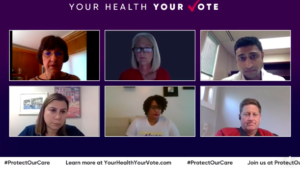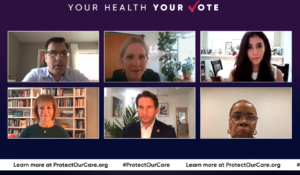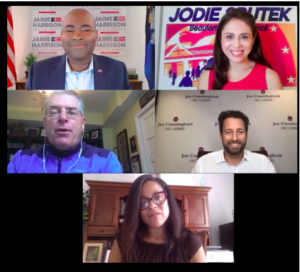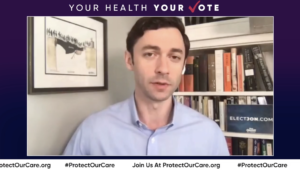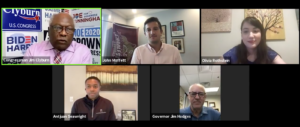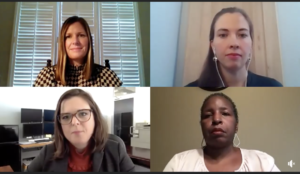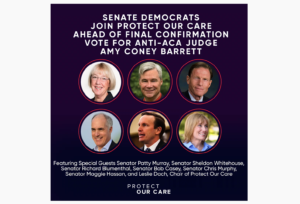
Over the course of the seven week, 18-state “Your Health, Your Vote” virtual bus tour, Protect Our Care held events in Pennsylvania, Wisconsin, Michigan, New Hampshire, Minnesota, Iowa, Maine, Arizona, Alaska, Colorado, Nevada, Texas, Virginia, Montana, North Carolina, South Carolina, Georgia and Florida. During each stop, members of Congress, U.S. Senate candidates, elected leaders, health care advocates and storytellers from each state met in a virtual format to discuss President Trump’s complete mismanagement of the coronavirus pandemic and highlight the danger of California v. Texas, the Trump-Republican lawsuit to dismantle the Affordable Care Act, which will be heard in the Supreme Court one week after the election. The lawsuit would take away protections for 135 million Americans with pre-existing conditions and rip coverage away from over 20 million Americans in the middle of a pandemic. Now, more than ever, Americans’ health care is on the ballot.
Protect Our Care held “closing argument” events focused on what’s at stake for health care in the election in Alaska, Arizona, Michigan, Florida, South Carolina, Minnesota, Iowa, New Hampshire, Georgia, North Carolina, Maine, Colorado and Wisconsin.
Protect Our Care’s nationwide events included:
- Seven United States Senate candidates including Speaker Sara Gideon (ME), Captain Mark Kelly (AZ), Dr. Al Gross (AK), Gov. Steve Bullock (MT), Cal Cunningham (NC), Jaime Harrison (SC) and Jon Ossoff (GA)
- Ten incumbent United States Senate Democrats including Senate Democratic Leader Chuck Schumer (NY), Senators Bob Casey (PA), Tammy Baldwin (WI), Jeanne Shaheen (NH), Tina Smith (MN), Catherine Cortez Masto (NV), Jacky Rosen (NV), Jon Tester (MT), Maggie Hassan (NH) and Mark Warner (VA)
- 22 Democratic Members of Congress including Speaker Nancy Pelosi (CA-12), Majority Whip Jim Clyburn (SC-06), Reps. Matt Cartwright (PA-08), Elissa Slotkin (MI-08), Chris Pappas (NH-01), Dean Phillips (MN-03), Cindy Axne (IA-03), Abby Finkenauer (IA-01), Tom O’Halleran (AZ-01), Jason Crow (CO-06), Dina Titus (NV-01), Susie Lee (NV-03), Colin Allred (TX-32), Lizzie Fletcher (TX-07), Abigail Spanberger (VA-07), G.K. Butterfield (NC-01), Joe Cunningham (SC-01), Lucy McBath (GA-06), Ruben Gallego (AZ-07), Val Demings (D-FL-10), Debbie Mucarsel-Powell (D-FL-26) and Gwen Moore (WI-04)
- Five Democratic Congressional candidates including Dr. Hiral Tipirneni (AZ-06), Dr. Cameron Webb (VA-05), former Justice Pat Timmons-Goodson (NC-08), Deborah Ross (NC-02) and Moe Davis (NC-11).
“YOUR HEALTH, YOUR VOTE” VIRTUAL BUS TOUR EVENTS
NATIONAL KICK OFF:
Monday, September 14, 2020: House Speaker Nancy Pelosi (D-CA) and Senate Democratic Leader Chuck Schumer (D-NY) joined Protect Our Care to kick off the “Your Health, Your Vote” virtual bus tour to make sure voters know health care is on the ballot in November. Since taking office, President Trump and his Republican allies in Congress have been waging a war on health care including their botched coronavirus response, refusal to provide Americans with meaningful COVID relief through legislation, proposed cuts to Medicaid and Medicare and failure to lower the cost of prescription drugs.

Watch the Full Event Here
Tour Announcement
Politico Pulse: PROTECT OUR CARE HITS “ROAD” WITH VIRTUAL TOUR
PENNSYLVANIA
Tuesday, September 15, 2020: Protect Our Care’s nationwide virtual “Your Health, Your Vote” tour arrived in Pennsylvania to highlight Republicans’ ongoing war on health care and failed coronavirus response. Headlined by U.S. Senator Bob Casey (D-PA), U.S. Representative Matt Cartwright (D-PA-08) Marked by COVID founder Kristin Urquiza and health care advocated Erin Gabriel, the event highlighted how Trump’s health care sabotage, including a lawsuit to completely dismantle the Affordable Care Act during a pandemic, would impact Pennsylvanians’ care. They also called on Republicans to denounce Trump’s war on health care and discussed Democrats’ agenda to improve health care and lower costs for Americans.

Watch the Full Event Here
Coverage:
The Times Leader (Wilkes-Barre, PA): Casey, Cartwright Highlight What’s at Stake for Health Care in Election
WISCONSIN
Thursday, September 17, 2020: Protect Our Care’s nationwide virtual “Your Health, Your Vote” tour arrived in Wisconsin to highlight Republicans’ ongoing war on health care and failed coronavirus response. Headlined by U.S. Senator Tammy Baldwin (D-WI), Wisconsin Attorney General Josh Kaul, former U.S. Secretary of Health and Human Services Kathleen Sebelius, the event highlighted how Trump’s health care sabotage, including a lawsuit to completely dismantle the Affordable Care Act during a pandemic, would impact Wisconsinites’ care.

Watch the Full Event Here
Coverage
WSAW (Wausau, WI): Wis. Democrats Hold Virtual Panel Events as Pres. Trump Visits Mosinee
Channel 3000 (Madison, WI): Democrats Hold ‘Your Health, Your Vote’ Event Ahead of President’s Wisconsin Visit
Milwaukee Journal Sentinel: Donald Trump Tears Into Joe Biden in Return Visit to Wisconsin
MICHIGAN
Tuesday, September 22, 2020: Protect Our Care’s nationwide virtual “Your Health, Your Vote” tour arrived in Michigan to highlight Republicans’ ongoing war on health care and failed coronavirus response. Headlined by U.S. Representative Elissa Slotkin (D-MI-08), the event highlighted how Trump’s health care sabotage, including a lawsuit to completely dismantle the Affordable Care Act during a pandemic, would impact Michiganders’ health care. They also called on Republicans to denounce Trump’s war on health care and discussed Democrats’ agenda to improve health care and lower costs for Americans.

Watch the Event Here
NEW HAMPSHIRE
Thursday, September 24, 2020: Protect Our Care’s nationwide virtual “Your Health, Your Vote” tour arrived in the Granite State to highlight the ongoing war on health care and failed local and federal coronavirus response. Headlined by U.S. Senator Jeanne Shaheen (D-NH) and U.S. Representative Chris Pappas (D-NH-01) and Marked By Covid founder Kristin Urquiza, the event highlighted how Donald Trump’s health care sabotage, including a lawsuit to completely dismantle the Affordable Care Act during a pandemic.

Watch the Event Here
Coverage
WMUR-9: NH Primary Source: Pappas, Shaheen to Join ‘Protect Our Care’ Virtual Bus Tour
MINNESOTA
Friday, September 25, 2020: Protect Our Care’s nationwide virtual “Your Health, Your Vote” tour arrived in Minnesota to highlight Republicans’ ongoing war on health care and failed coronavirus response. Headlined by U.S. Senator Tina Smith (D-MN) and U.S. Representative Dean Phillips (D-MN-03), the event highlighted how Trump’s health care sabotage, including a lawsuit to completely dismantle the Affordable Care Act during a pandemic, would impact Minnesotans’ care. Sarah Stoesz, the President and CEO of Planned Parenthood North Central States, Clara Boykin, a member of SEIU Healthcare Minnesota, Kenza Hadj-Moussa of TakeAction also joined the event. Speakers discussed the dire emergency created by the Trump-Republican lawsuit to overturn the Affordable Care Act as well as the upcoming battle over Trump’s intent to fill a U.S. Supreme Court seat with a Justice who opposes the ACA, which would throw our entire health care system into chaos.

Watch the Event Here
IOWA
Thursday, October 1, 2020: Protect Our Care’s nationwide virtual “Your Health, Your Vote” tour arrived in Iowa to highlight Republicans’ ongoing war on health care and failed coronavirus response. Headlined by former Sen. Tom Harkin along with U.S. Representatives Cindy Axne (IA-03) and Abby Finkenauer (IA-01), the event highlighted how Trump’s health care sabotage, including a lawsuit to completely dismantle the Affordable Care Act during a pandemic, would impact Iowans’ care. They also called on Sen. Joni Ernst to denounce Trump’s war on health care and discussed Democrats’ agenda to improve health care and lower costs for Americans.

Watch the Event Here
MAINE
Friday, October 2, 2020: This morning, Protect Our Care’s nationwide virtual “Your Health, Your Vote” tour arrived in Maine to highlight Republicans’ ongoing war on health care and failed coronavirus response. Headlined by Maine Speaker of the House Sara Gideon and Maine Senate President Troy Jackson, the event highlighted how Trump’s health care sabotage, including a lawsuit to overturn the Affordable Care Act during a pandemic, would impact Mainers’ care. They also called on Sen. Susan Collins to denounce Trump’s war on health care and discussed Democrats’ agenda to improve health care and lower costs for Americans.

Watch the Event Here
ARIZONA
Tuesday, October 6, 2020: Protect Our Care’s nationwide virtual “Your Health, Your Vote” tour arrived in Arizona to highlight Republicans’ ongoing war on health care and failed coronavirus response. Headlined by U.S. Representative Tom O’Halleran (D-AZ-01), United States Senate candidate Captain Mark Kelly, State Senator Jamescita Peshlakai, and U.S. House candidate Dr. Hiral Tipirneni (D-AZ-06), the event highlighted how Trump’s health care sabotage, including a lawsuit to completely dismantle the Affordable Care Act during a pandemic, would impact Arizona’s care. They also called on Martha McSally to denounce Trump’s war on health care and discussed Democrats’ agenda to improve health care and lower costs for Americans.

Watch the Event Here
Coverage
Tucson Local Media: O’Halleran, Democrats Keep Campaign Focus on Health Care Issues
AZ Central: ‘A Pretty Lethal Pandemic’: Arizona Deaths Have Spiked 22% So Far This Year
ALASKA
Wednesday, October 7, 2020: Protect Our Care’s nationwide virtual “Your Health, Your Vote” tour arrived in Alaska to highlight how Republicans’ ongoing war on health care and failed coronavirus response has left Alaskans at risk. Headlined by Dr. Al Gross, a former orthopedic surgeon and candidate for the US Senate, the event highlighted how Trump’s health care sabotage, including a lawsuit to completely dismantle the Affordable Care Act during a pandemic, would impact Alaskans’ care. Speakers also called on Senator Dan Sullivan to denounce Trump’s war on health care and discussed Democrats’ agenda to improve health care and lower costs for Americans.

Watch the Event Here
COLORADO
Monday, October 12, 2020: Protect Our Care Colorado was joined by U.S. Representative Jason Crow (D-CO-06), and Colorado health care advocates to discuss how Trump’s health care sabotage, including a lawsuit to completely dismantle the Affordable Care Act during a pandemic, would impact Coloradans’ care. Participants also called on Senator Cory Gardner to denounce Trump’s war on health care and discussed Democrats’ agenda to improve health care and lower costs for Americans. Advocates urged Senator Cory Gardner to take steps to protect them, and end his attacks on Coloradans’ health care.

Watch the Event Here
Coverage
Colorado Times Recorder: Crow Criticizes Republicans for Trying to Kill the Affordable Care Act Instead of Working To Improve It
NEVADA
Tuesday, October 13, 2020: Protect Our Care’s nationwide virtual “Your Health, Your Vote” tour arrived in southern Nevada to highlight Republicans’ ongoing war on health care and failed coronavirus response. Headlined by U.S. Senators Catherine Cortez Masto (D-NV) and Jacky Rosen (D-NV) and U.S. Representatives Dina Titus (D-NV-01) and Susie Lee (D-NV-03), the event highlighted how Trump’s health care sabotage, including a lawsuit to completely dismantle the Affordable Care Act during a pandemic, would impact Nevadans’ care. Speakers included Kevin Scott Carey, President SEIU Nevada Local 1107, Laura Martin, PLAN (Progressive Leadership Alliance Nevada), Raquel Cruz-Juarez, Planned Parenthood of the Rocky Mountains, and Erika Washington, Make it Work Nevada, who also called on the GOP to denounce Trump’s war on health care and discussed Democrats’ agenda to improve health care and lower costs for Americans.

Watch the Event Here
Coverage
Las Vegas Sun: Top Nevada Democrats Urge GOP to Put Health Care Above Court Politics
TEXAS
Wednesday, October 14, 2020: Protect Our Care’s nationwide virtual “Your Health, Your Vote” tour arrived in Texas to highlight Republicans’ ongoing war on health care and failed coronavirus response. Headlined by U.S. Representatives Colin Allred (D-TX-32) and Lizzie Fletcher (D-TX-07), the event highlighted how Trump’s ongoing war on America’s health care, his lawsuit to completely dismantle the Affordable Care Act during a pandemic, and his failed coronavirus response have had devastating impacts on Texans. They also held Sen. John Cornyn for his failure as part of the Republican Senate leadership to failure Majority Leader Mitch McConnell to negotiate or pass a meaningful coronavirus relief package for Americans who are suffering from the impacts of the pandemic. The House, including Reps. Allred and Fletcher, passed a relief bill 152 days ago, with no meaningful response from the Senate.

Watch the Event Here
VIRGINIA
Friday, October 16, 2020: Protect Our Care’s nationwide virtual “Your Health, Your Vote” tour arrived in Virginia to highlight Republicans’ ongoing war on health care and failed coronavirus response. Headlined by U.S. Senator Mark Warner (D-VA), U.S. Representative Abigail Spanberger (D-VA-07), U.S. House candidate Dr. Cameron Webb (D-VA-05) and Marked by COVID founder Kristin Urquiza, the event highlighted Trump’s selection of an anti-ACA justice for the Supreme Court and his lawsuit to completely dismantle the Affordable Care Act during a pandemic, which would have devastating impacts on Virginians’ care. They also discussed Democrats’ agenda to improve health care and lower costs for Americans.

Watch the Event Here
MONTANA
Friday, October 16, 2020: Protect Our Care’s nationwide virtual tour arrived in Montana, headlined by U.S. Senator Jon Tester (D-MT) and Governor Steve Bullock (D-MT), to discuss the importance of the Affordable Care Act to Montanans and to highlight what’s at stake for Montanans’ health care if the ACA is repealed. They also discussed the significance of access to affordable healthcare particularly in the middle of the COVID-19 pandemic. Community members, including Dr. Anne Giuliano and Rep. Sharon Stewart Peregoy, carried messages from communities directly impacted by the ACA and Medicaid expansion, highlighting the importance of access to preventative and consistent care. Speakers included Amy Allen of the Forward Montana Foundation, Elizabeth Marum, a member of Big Sky 55+, and Emily Allison of Forward Montana and Bridgercare.

Watch the Event Here
NORTH CAROLINA
Monday, October 19, 2020: Protect Our Care’s nationwide virtual “Your Health, Your Vote” tour arrived in North Carolina to highlight Republicans’ ongoing war on health care and failed coronavirus response. Headlined by U.S. Senate candidate Cal Cunningham, Attorney General Josh Stein, U.S. Representative G.K. Butterfield (D-NC-01) and U.S. House candidate, former Justice Pat Timmons-Goodson (D-NC-08), the event highlighted how Trump’s health care sabotage, including a lawsuit to completely dismantle the Affordable Care Act during a pandemic, would impact North Carolinians’ care. They also called on Senator Thom Tillis to denounce Trump’s war on health care and discussed Democrats’ agenda to improve health care and lower costs for Americans.

Watch the Event Here
Coverage
The News & Observer: Cunningham won’t talk personal scandal, keeps his focus on health care in Senate race
WJZY, WFXB, WGHP, WNCN, WNCT: Coverage of Event
SOUTH CAROLINA
Wednesday, October 21, 2020: Protect Our Care’s nationwide virtual “Your Health, Your Vote” tour arrived in South Carolina to highlight Republicans’ ongoing war on health care and failed coronavirus response. Headlined by U.S. Representative Joe Cunningham (D-SC-01) along with U.S. Senate candidate and former South Carolina Democratic Party Chair Jaime Harrison, the event highlighted how Trump’s health care sabotage, including a lawsuit to completely dismantle the Affordable Care Act during a pandemic, would impact South Carolinians’ care. They also called on Senator Lindsey Graham to denounce Trump’s war on health care and discussed Democrats’ agenda to improve health care and lower costs for Americans.

Watch the Event Here
Coverage
NBC News 2: Congressman Joe Cunningham and Senate candidate Jaime Harrison participating in virtual tour stop
ABC News 4: Rep. Cunningham and Jaime Harrison headline virtual “Your Health, Your Vote” tour stop
GEORGIA
Thursday, October 22, 2020: Protect Our Care’s nationwide virtual “Your Health, Your Vote” tour arrived in Georgia to highlight Republicans’ ongoing war on health care and failed coronavirus response. Headlined by U.S. Representative Lucy McBath (D-GA-06), U.S. Senate candidate Jon Ossoff (D-GA) and Andy Slavitt, former Acting Administrator for the Centers for Medicare and Medicaid Services, the event highlighted how Trump’s health care sabotage, including a lawsuit to completely dismantle the Affordable Care Act during a pandemic, would impact Georgians’ care. They also called on Senators Kelly Loeffler and David Perdue to denounce Trump’s war on health care and discussed Democrats’ agenda to improve health care and lower costs for Americans.

Watch the Event Here
FLORIDA
Thursday, October 29, 2020: U.S. Representatives Val Demings (D-FL-10) and Debbie Mucarsel-Powell (D-FL-26) joined health care advocates and local residents from South and Central Florida as the last stop on Protect Our Care’s nationwide virtual bus tour to call for an end to the GOP’s continued war on Floridians’ health care.

Watch the Event Here
CLOSING ARGUMENT EVENTS:
ALASKA
Saturday, October 24, 2020: Meda Dewitt, Allie Phillips, Leighan Gonzales, Richard Drake, Susanna Orr, Derek Reed, and Joni Bruner joined Protect Our Care Alaska and S’Up Alaska for a press conference outside Senator Dan Sullivan’s office in Anchorage to discuss what is at stake for Alaskans’ health care in the 2020 election, and highlight the threat that President Trump’s Supreme Court nominee represents to the thousands of Alaskans who rely on the Affordable Care Act for access to quality, affordable health care.

Watch the Event Here
Wednesday, October 28, 2020: Alaskans Media Dewitt, Nick Moe, James C. Paoli, Lee Haywood, and others held an event outside of Sens. Sullivan and Murkowksi to speak out about what’s at stake for the health care of Alaskans in this election. Advocates also spoke out against these Republican senators voting to approve Trump’s Supreme Court nominee and the threat that poses to the Affordable Care Act.

Watch the Event Here
ARIZONA
Tuesday, October 27, 2020: U.S. Representative Ruben Gallego (D-AZ-07), State Representative Kelli Butler, Tucson Emergency Medical Doctor Larry DeLuca, and rare illness survivor Alicia DeWitt joined Protect Our Care Arizona for a virtual press conference to discuss Senator Martha McSally’s final health care betrayal — voting to confirm an anti-ACA Supreme Court Justice while millions of Arizonans’ health care hangs in the balance.

Watch the Event Here
Coverage
Tucson Weekly: Healthcare Advocacy Group Blasts McSally for Supreme Court Vote
MICHIGAN
Tuesday, October 27, 2020: Ahead of President Donald Trump’s visit to Lansing, doctors and health care advocates joined Protect Our Care Michigan in urging voters to cast their ballots for candidates who will protect the Affordable Care Act (ACA). The doctors aimed to emphasize that health care is on the ballot because of Trump and Republican efforts to repeal the ACA via a lawsuit the Supreme Court will begin to hear arguments for one week after the election. Republicans have also confirmed Judge Amy Coney Barrett to the Supreme Court, who has spoken against the ACA. Health care workers urged voters to cast ballots for Joe Biden and Michigan Sen. Gary Peters, as well as local Democratic candidates.

Watch the Event Here
Coverage
Newsweek: Michigan Doctors Say Trump’s Lansing Rally Will ‘Only Make Things Worse’ as COVID Cases Rise
CNBC: Health Care Workers in Michigan Criticize Trump’s Rally Amid Record Covid Cases
SOUTH CAROLINA
Thursday, October 29, 2020: House Majority Whip Jim Clyburn (D-SC-06), Former Gov. Jim Hodges, Antjuan Seawright, and Olivia Rothstein joined Protect Our Care South Carolina to discuss what is at stake for South Carolinians’ health care in this election. On November 10, one week after the election, the Supreme Court will hear oral arguments in California v. Texas, the lawsuit led by the Trump administration and 18 Republican state Attorneys General to dismantle the Affordable Care Act. For years, Republicans have attempted to sabotage and destroy the ACA. If Republicans succeed, they threaten to destroy access to health care for millions of Americans and 288,000, and to eliminate protections for people with pre-existing conditions, including 2,027,400 South Carolinians. Speakers highlighted the dire emergency created by the Trump administration and Republicans pushing to repeal the ACA when South Carolinians need it the most.

Watch the Event Here
Coverage
WCIV: Majority Whip Clyburn, Former Gov. Hodges Speak on Health Care and the Election
MINNESOTA
Thursday, October 29, 2020: Attorney General Keith Ellison, State Senator Matt Klein, State Rep. Jennifer Schultz and Minnesotans joined Protect Our Care Minnesota for a virtual press conference to discuss what is at stake for Minnesotans’ health care in this election. On November 10, one week after the election, the Supreme Court will hear oral arguments in California v. Texas, the lawsuit led by the Trump administration and 18 Republican state Attorneys General to dismantle the Affordable Care Act.

Watch the Event Here
IOWA
Thursday, October 29, 20200: Iowans and health care advocates joined Progress Iowa and Protect Our Care Iowa for a press call to discuss what is at stake for Iowans’ health care in this election, and to release a health care voter guide for the state.

Watch the Event Here
NEW HAMPSHIRE
Thursday, October 29, 2020: New Hampshire Insurance Commissioner Chris Nicopoulos, U.S. Representative Chris Pappas (D-NH-01), Professor Lucy Hodder, and NH Navigator Program Director Jeremy Smith joined Covering New Hampshire and Protect Our Care New Hampshire for a virtual press conference to preview the upcoming Open Enrollment period and to provide Granite Staters with the resources they need to get health care coverage through the Affordable Care Act during this critical time.

Watch the Event Here
Coverage
Concord Monitor: ACA Health Insurance Enrollment Period Starts Nov. 1
GEORGIA
Thursday, October 29, 2020: Concerned women of Georgia joined Protect Our Care Georgia for a virtual press conference to discuss what is at stake for Georgia women’s health care in this election. President Trump’s failure to adequately respond to the pandemic has had unique social, economic, and health implications for women. Making matters worse, President Trump is currently backing a lawsuit that would overturn the Affordable Care Act (ACA) as the nation is still reeling from the pandemic. Without the ACA, women would lose critical protections and face even higher costs for care. Speakers highlighted the dire emergency created by the Trump administration and Republicans pushing to repeal the ACA when the women of Georgia need it the most.

Watch the Event Here
NORTH CAROLINA
Friday, October 30, 2020: U.S. House candidates Deborah Ross (D-NC-02) and Moe Davis (D-NC-11), State Rep. Carla Cunningham, and health care advocates from across North Carolina joined Protect Our Care North Carolina for a virtual press conference to discuss what is at stake for North Carolinians health care in this election. On November 10, one week after the election, the Supreme Court will hear oral arguments in California v. Texas, the lawsuit led by the Trump administration and 18 Republican state Attorneys General to dismantle the Affordable Care Act.

Watch the Event Here
MAINE
Friday, October 30, 2020: Maine Attorney General Aaron Frey, state lawmakers, patient storytellers and advocates joined Protect Our Care Maine for a press call to discuss what is at stake for Mainers’ health care in this election. On November 10, one week after the election, the Supreme Court will hear oral arguments in the Trump administration and Republicans’ lawsuit to eliminate the Affordable Care Act.
Listen to Call Recording Here
COLORADO
Friday, October 30, 2020: Coloradans with pre-existing conditions joined Protect Our Care to discuss what is at stake for Coloradans’ health care in this election. Health care advocates will be joined by representatives of organizations for reproductive health, voters’ rights, and racial and social justice to tell Senator Gardner how he’s failed to represent Coloradans. On November 10, one week after the election, the Supreme Court will hear oral arguments in the Trump administration and Republicans’ lawsuit to eliminate the Affordable Care Act.

Watch the Event Here
WISCONSIN
Friday, October 30, 2020: U.S. Representative Gwen Moore (D-WI-04), State Treasurer Sarah Godlewski, Dr. Amy Fiedler and Wisconsin resident Megan McGee joined Protect Our Care Wisconsin for a virtual press conference focusing on what is at stake for Wisconsinites’ health care in this election. On November 10, just one week after the election, the Supreme Court will hear oral arguments in the Trump administration and Republicans’ lawsuit to eliminate the Affordable Care Act.

Watch the Event Here





